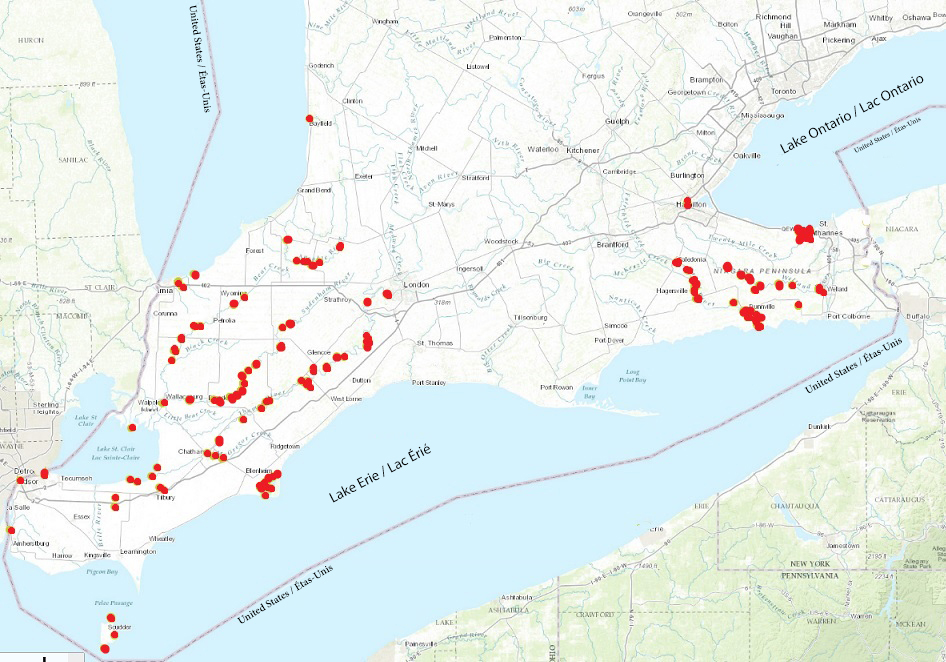Mapleleaf (Quadrula quadrula) specific populations: species at risk consultation
Information summary and survey for the consultations on potentially down-listing Mapleleaf (Great Lakes – Upper St. Lawrence populations) on the List of Wildlife Species at Risk from Threatened to Special Concern – Please provide input by May 1, 2017.
Consultations
Let your opinion be heard
Canada’s Species at Risk Act (SARA) provides legal protection for wildlife species at risk to conserve biological diversity. It also acknowledges that all Canadians have a role to play in the conservation of wildlife species.
Before deciding whether Mapleleaf (Quadrula quadrula) (Great Lakes – Upper St. Lawrence populations) (Mapleleaf, from this point forward) will be down-listed on the List of Wildlife Species at Risk from Threatened to Special Concern, we would like to hear your opinion, comments, and suggestions regarding the possible ecological, cultural, and economic impacts of down-listing or not down-listing this species under SARA.
Down-listing a species from Threatened to Special Concern on the List of Wildlife Species at Risk
The process of down-listing a species under SARA consists of several steps: it begins with a status reassessment by the Committee on the Status of Endangered Wildlife in Canada (COSEWIC) and ends with a Government of Canada decision on whether or not to down-list a species on the List of Wildlife Species at Risk. Public consultations are conducted to gather the opinions of Canadians and are an important step in this process.
Facts about the Mapleleaf

The Mapleleaf is a medium to large freshwater mussel that is named after its shape, which resembles a maple tree leaf. It has a thick, square-shaped shell with two raised ridges of nodules that form a v-shape. Shell colour varies from yellow-green to brown. Individuals can reach 125 mm in length, 100 mm in height and 50 mm in width.
Mapleleaf is usually found in medium to large rivers with slow to moderate currents and firmly packed substrate of sand, coarse gravel or clay/mud.
In Canada, Mapleleaf is found in several larger rivers draining into Lake St. Clair, Lake Erie, and Lake Ontario, including the Sydenham, Ausable, Grand and Thames rivers, Hamilton Harbour, and Jordan Harbour (Figure 1).
Who assigned the Special Concern status to Mapleleaf?
COSEWIC is an independent committee of experts that assesses which wildlife species are in some danger of disappearing from Canada and assigns a status to these species. It conducts its assessments based on the best available information including scientific data, local ecological knowledge, and Aboriginal traditional knowledge. In 2016, COSEWIC reassessed Mapleleaf as Special Concern. Under SARA, a Special Concern species is defined as one that may become a Threatened or an Endangered species because of a combination of biological characteristics and identified threats.

Figure 1. Distribution of Mapleleaf (Great Lakes – Upper St. Lawrence populations) in Canada (DFO unpublished data).
Why is Mapleleaf at risk?
COSEWIC re-assessed Mapleleaf as Special Concern because of newly discovered locations that came to light as a result of increased sampling effort. Additionally, evidence of recent gene flow across Lake Erie suggests that there is the potential for re-colonization should the species disappear from Canadian waters. However, there is still evidence an ongoing decline in the species’ range over the last three generations, although this decline is slight. Threats to the species include impacts of the invasive Zebra and Quagga mussels (Dreissena polymorpha, D. bugensis), habitat alteration, and pollution.
Over the past several years, Mapleleaf has received ongoing benefit from ecosystem-based recovery programs for several watersheds with populations present (e.g., Ausable, Thames, Grand and Sydenham rivers). Recovery activities implemented include research and monitoring programs and active stewardship and outreach/ awareness programs to reduce identified threats.
If a species is down-listed under the Species at Risk Act
If Mapleleaf is down-listed from Threatened to Special Concern, the prohibitions of SARA would no longer apply. However, Fisheries and Oceans Canada would be required to produce a SARA Management Plan (to replace the existing Recovery Strategy and Action Plan) for the species in an effort to ensure that it does not become Endangered due to human activity.
Before completing this survey, you may wish to review the following background information found at the links below:
- Recovery Strategy and Action Plan for the Mapleleaf (Quadrula quadrula) in Canada (Great Lakes-Upper St. Lawrence Population) (PDF 4.23 MB)
- Additional information on the species can be found on the Species at Risk Public Registry.
We would like to receive your comments on the potential impacts of down-listing or not down-listing Mapleleaf on the List of Wildlife Species at Risk under SARA from Threatened to Special Concern. Your comments are important.
Please fill out the survey: we want to hear from you.
Thank you for completing this survey.
Species at Risk Program, Central and Arctic Region
867 Lakeshore Road
Burlington, Ontario, L7S 1A1
fwisar@dfo-mpo.gc.ca